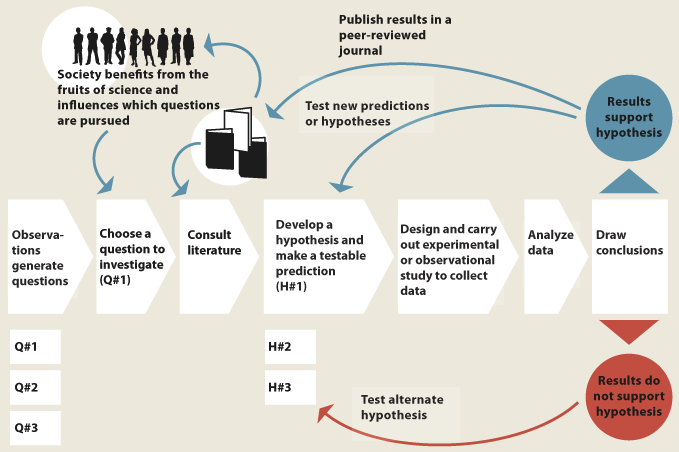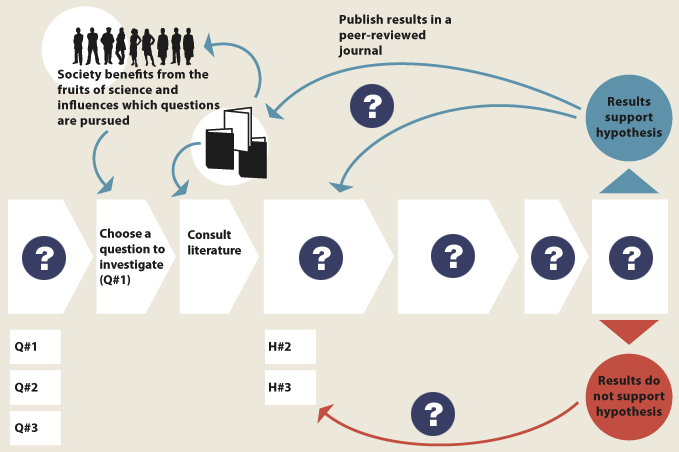Chapter 1. Infographics
Introduction
Infographic Demo Activity
This shows off DigFir's capabilities with Infographic images.
Certainty in Science
Infographic 2.2: Certainty in Science
Question 1Certainty in Science
Click on the item or items in this Infographic that represent the varying degrees of certainty in science (some levels of certainty are not considered a part of science).
{"title":"no clue","description":"Obviously no clue does not reflect certainty.","type":"incorrect","color":"#99CCFF","code":"[{\"shape\":\"rect\",\"coords\":\"11,16,89,55\"}]"} {"title":"hypothesis","description":"A hypothesis indicates some certainty... One of the other items reflects some certainty as well.","type":"correct","color":"#993300","code":"[{\"shape\":\"rect\",\"coords\":\"91,16,395,55\"}]"} {"title":"theory","description":"A theory is about as much certainty as you can get in science... One of the other items reflects some certainty as well.","type":"correct","color":"#333300","code":"[{\"shape\":\"rect\",\"coords\":\"396,15,470,54\"}]"} {"title":"absolute proof","description":"Absolute proof is not attainable in science.","type":"incorrect","color":"#000080","code":"[{\"shape\":\"rect\",\"coords\":\"471,15,600,54\"}]"}
There are degrees of certainty in science—we know some ideas are better than others. The more evidence we have in support of an idea, especially when the evidence comes from different lines of inquiry, the more certain we are that we are on the right track. But since all scientific information is open to further evaluation, we do not expect or require “absolute” proof.)
The Scientific Process
Infographic 2.3: The Scientific Process
Question 2
Click on the marker in this Infographic that represents the step in the scientific process where scientists analyze data.
{"title":"analyze data","description":"Once a study is conducted and data gathered, the data are evaluated to determine whether they confirm or fail to confirm the hypothesis.","type":"correct","color":"#99CCFF","code":"[{\"shape\":\"rect\",\"coords\":\"526,200,590,316\"}]"} {"title":"design and carry out experiment","description":"Try again.","type":"incorrect","color":"#993300","code":"[{\"shape\":\"rect\",\"coords\":\"397,200,518,315\"}]"} {"title":"develop a hypothesis","description":"Try again.","type":"incorrect","color":"#333300","code":"[{\"shape\":\"rect\",\"coords\":\"265,200,393,315\"}]"} {"title":"draw conclusions","description":"Try again.","type":"incorrect","color":"#000080","code":"[{\"shape\":\"rect\",\"coords\":\"593,200,668,315\"}]"} {"title":"observations generate questions","description":"Try again.","type":"incorrect","color":"#333333","code":"[{\"shape\":\"rect\",\"coords\":\"9,200,93,315\"}]"} {"title":"test alternate hypothesis","description":"Try again.","type":"incorrect","color":"#800000","code":"[{\"shape\":\"circle\",\"coords\":\"433,414,25\"}]"} {"title":"test new prediction or hypothesis","description":"Try again.","type":"incorrect","color":"#FF6600","code":"[{\"shape\":\"circle\",\"coords\":\"372,106,24\"}]"}Question 3
Click on the marker in this Infographic that represents the step in the scientific process where scientists design and carry out an experimental or observational study to collect data.
{"title":"analyze data","description":"Try again.","type":"incorrect","color":"#99CCFF","code":"[{\"shape\":\"rect\",\"coords\":\"526,200,590,316\"}]"} {"title":"design and carry out experiment","description":"Scientists design a study to gather evidence to test predictions made from their hypotheses. Different types of studies amass a body of evidence.","type":"correct","color":"#993300","code":"[{\"shape\":\"rect\",\"coords\":\"397,200,518,315\"}]"} {"title":"develop a hypothesis","description":"Try again.","type":"incorrect","color":"#333300","code":"[{\"shape\":\"rect\",\"coords\":\"265,200,393,315\"}]"} {"title":"draw conclusions","description":"Try again.","type":"incorrect","color":"#000080","code":"[{\"shape\":\"rect\",\"coords\":\"593,200,668,315\"}]"} {"title":"observations generate questions","description":"Try again.","type":"incorrect","color":"#333333","code":"[{\"shape\":\"rect\",\"coords\":\"9,200,93,315\"}]"} {"title":"test alternate hypothesis","description":"Try again.","type":"incorrect","color":"#800000","code":"[{\"shape\":\"circle\",\"coords\":\"433,414,25\"}]"} {"title":"test new prediction or hypothesis","description":"Try again.","type":"incorrect","color":"#FF6600","code":"[{\"shape\":\"circle\",\"coords\":\"372,106,24\"}]"}Question 4
Click on the marker in this Infographic that represents the step in the scientific process where scientists develop a hypothesis and make a testable prediction (H#1).
{"title":"analyze data","description":"Try again.","type":"incorrect","color":"#99CCFF","code":"[{\"shape\":\"rect\",\"coords\":\"526,200,590,316\"}]"} {"title":"design and carry out experiment","description":"Try again.","type":"incorrect","color":"#993300","code":"[{\"shape\":\"rect\",\"coords\":\"397,200,518,315\"}]"} {"title":"develop a hypothesis","description":"Scientific hypotheses must be testable (generate predictions about what we could objectively observe if we conducted the test). In turn, these predictions must be falsifiable, meaning that it would be possible to produce evidence that shows the prediction is wrong.","type":"correct","color":"#333300","code":"[{\"shape\":\"rect\",\"coords\":\"265,200,393,315\"}]"} {"title":"draw conclusions","description":"Try again.","type":"incorrect","color":"#000080","code":"[{\"shape\":\"rect\",\"coords\":\"593,200,668,315\"}]"} {"title":"observations generate questions","description":"Try again.","type":"incorrect","color":"#333333","code":"[{\"shape\":\"rect\",\"coords\":\"9,200,93,315\"}]"} {"title":"test alternate hypothesis","description":"Try again.","type":"incorrect","color":"#800000","code":"[{\"shape\":\"circle\",\"coords\":\"433,414,25\"}]"} {"title":"test new prediction or hypothesis","description":"Try again.","type":"incorrect","color":"#FF6600","code":"[{\"shape\":\"circle\",\"coords\":\"372,106,24\"}]"}Question 5
Click on the marker in this Infographic that represents the step in the scientific process where scientists draw conclusions.
{"title":"analyze data","description":"Try again.","type":"incorrect","color":"#99CCFF","code":"[{\"shape\":\"rect\",\"coords\":\"526,200,590,316\"}]"} {"title":"design and carry out experiment","description":"Try again.","type":"incorrect","color":"#993300","code":"[{\"shape\":\"rect\",\"coords\":\"397,200,518,315\"}]"} {"title":"develop a hypothesis","description":"Try again.","type":"incorrect","color":"#333300","code":"[{\"shape\":\"rect\",\"coords\":\"265,200,393,315\"}]"} {"title":"draw conclusions","description":"If a hypothesis is rejected, alternative hypotheses can be tested. If a hypothesis is confirmed, the researchers should repeat the study to validate the data. They can also generate new predictions that test the same hypothesis from different angles. As evidence mounts from replicate studies and from multiple predictions, we become more confident in our data and conclusions.","type":"correct","color":"#000080","code":"[{\"shape\":\"rect\",\"coords\":\"593,200,668,315\"}]"} {"title":"observations generate questions","description":"Try again.","type":"incorrect","color":"#333333","code":"[{\"shape\":\"rect\",\"coords\":\"9,200,93,315\"}]"} {"title":"test alternate hypothesis","description":"Try again.","type":"incorrect","color":"#800000","code":"[{\"shape\":\"circle\",\"coords\":\"433,414,25\"}]"} {"title":"test new prediction or hypothesis","description":"Try again.","type":"incorrect","color":"#FF6600","code":"[{\"shape\":\"circle\",\"coords\":\"372,106,24\"}]"}Question 6
Click on the marker in this Infographic that represents the step in the scientific process where observations generate questions.
{"title":"analyze data","description":"Try again.","type":"incorrect","color":"#99CCFF","code":"[{\"shape\":\"rect\",\"coords\":\"526,200,590,316\"}]"} {"title":"design and carry out experiment","description":"Try again.","type":"incorrect","color":"#993300","code":"[{\"shape\":\"rect\",\"coords\":\"397,200,518,315\"}]"} {"title":"develop a hypothesis","description":"Try again.","type":"incorrect","color":"#333300","code":"[{\"shape\":\"rect\",\"coords\":\"265,200,393,315\"}]"} {"title":"draw conclusions","description":"Try again.","type":"incorrect","color":"#000080","code":"[{\"shape\":\"rect\",\"coords\":\"593,200,668,315\"}]"} {"title":"observations generate questions","description":"Observations consist of information detected with the senses—or with equipment that extends our senses. Observations suggestion questions about what might have caused the observed phenomenon.","type":"correct","color":"#333333","code":"[{\"shape\":\"rect\",\"coords\":\"9,200,93,315\"}]"} {"title":"test alternate hypothesis","description":"Try again.","type":"incorrect","color":"#800000","code":"[{\"shape\":\"circle\",\"coords\":\"433,414,25\"}]"} {"title":"test new prediction or hypothesis","description":"Try again.","type":"incorrect","color":"#FF6600","code":"[{\"shape\":\"circle\",\"coords\":\"372,106,24\"}]"}Question 7
Click on the marker in this Infographic that represents the step in the scientific process where scientists test alternate hypothesis.
{"title":"analyze data","description":"Try again.","type":"incorrect","color":"#99CCFF","code":"[{\"shape\":\"rect\",\"coords\":\"526,200,590,316\"}]"} {"title":"design and carry out experiment","description":"Try again.","type":"incorrect","color":"#993300","code":"[{\"shape\":\"rect\",\"coords\":\"397,200,518,315\"}]"} {"title":"develop a hypothesis","description":"Try again.","type":"incorrect","color":"#333300","code":"[{\"shape\":\"rect\",\"coords\":\"265,200,393,315\"}]"} {"title":"draw conclusions","description":"Try again.","type":"incorrect","color":"#000080","code":"[{\"shape\":\"rect\",\"coords\":\"593,200,668,315\"}]"} {"title":"observations generate questions","description":"Try again.","type":"incorrect","color":"#333333","code":"[{\"shape\":\"rect\",\"coords\":\"9,200,93,315\"}]"} {"title":"test alternate hypothesis","description":"If the evidence does not support the hypothesis, then alternative hypothesis can be tested.","type":"correct","color":"#800000","code":"[{\"shape\":\"circle\",\"coords\":\"433,414,25\"}]"} {"title":"test new prediction or hypothesis","description":"Try again.","type":"incorrect","color":"#FF6600","code":"[{\"shape\":\"circle\",\"coords\":\"372,106,24\"}]"}Question 8
Click on the marker in this Infographic that represents the step in the scientific process where scientists test new prediction or hypotheses.
{"title":"analyze data","description":"Try again.","type":"incorrect","color":"#99CCFF","code":"[{\"shape\":\"rect\",\"coords\":\"526,200,590,316\"}]"} {"title":"design and carry out experiment","description":"Try again.","type":"incorrect","color":"#993300","code":"[{\"shape\":\"rect\",\"coords\":\"397,200,518,315\"}]"} {"title":"develop a hypothesis","description":"Try again.","type":"incorrect","color":"#333300","code":"[{\"shape\":\"rect\",\"coords\":\"265,200,393,315\"}]"} {"title":"draw conclusions","description":"Try again.","type":"incorrect","color":"#000080","code":"[{\"shape\":\"rect\",\"coords\":\"593,200,668,315\"}]"} {"title":"observations generate questions","description":"Try again.","type":"incorrect","color":"#333333","code":"[{\"shape\":\"rect\",\"coords\":\"9,200,93,315\"}]"} {"title":"test alternate hypothesis","description":"Try again.","type":"incorrect","color":"#800000","code":"[{\"shape\":\"circle\",\"coords\":\"433,414,25\"}]"} {"title":"test new prediction or hypothesis","description":"If a hypothesis is confirmed, the data must be validated, and new predictions can be made.","type":"correct","color":"#FF6600","code":"[{\"shape\":\"circle\",\"coords\":\"372,106,24\"}]"}
Full caption from infographic can appear here.
1.1 Activity Completed!
Activity results are being submitted...

